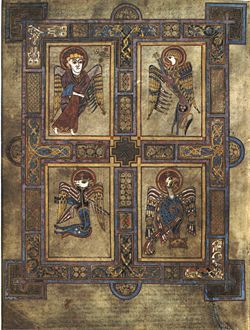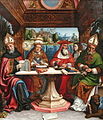Four Evangelists


Template:See also In Christian tradition the Four Evangelists are Matthew, Mark, Luke, and John, the authors attributed with the creation of the four Gospel accounts in the New Testament that bear the following titles:
- Gospel according to Matthew
- Gospel according to Mark
- Gospel according to Luke
- Gospel according to John
The gospels of Matthew, Mark, and Luke are known as the Synoptic Gospels because they include many of the same stories, often in the same sequence. Convention has traditionally held the authors to have been two of the Twelve Apostles of Jesus, John and Matthew, and two "apostolic men," Mark and Luke:
- Matthew – a former tax collector who was called by Jesus to be one of the Twelve Apostles,
- Mark – a follower of Peter and so an "apostolic man",
- Luke – a doctor who wrote what is now the book of Luke to a friend Theophilus. Also believed to have written the book of Acts (or Acts of the Apostles) and a close friend of Paul of Tarsus,
- John – a disciple of Jesus and possibly the youngest of his Twelve Apostles.
They are called evangelists, a word meaning people who proclaim good news, because their books aim to tell the good news of Jesus.[1]
Evangelists' symbols
[edit]
In iconography the evangelists often appear in Evangelist portraits derived from classical tradition, and are also frequently represented by the following symbols, which originate from the four "living creatures" that draw the throne-chariot of God, the Merkabah, in the vision in the Book of Ezekiel (Chapter 1) reflected in the Book of Revelation (4.6-9ff), though neither source links the creatures to the Evangelists. They are normally, but not invariably, all shown with wings like angels. The meanings accruing to the symbols grew over centuries, and were fully expressed by Rabanus Maurus, who set out three layers of meaning for the beasts, as representing firstly the Evangelists, secondly the nature of Christ, and thirdly the virtues required of a Christian for salvation:[2]
- Matthew the Evangelist, the author of the first gospel account is symbolized by a winged man, or angel. Matthew's gospel starts with Jesus' genealogy from Abraham; it represents Jesus' Incarnation, and so Christ's human nature. This signifies that Christians should use their reason for salvation.[citation needed]
- Mark the Evangelist, the author of the second gospel account is symbolized by a winged lion - a figure of courage and monarchy. Mark has John the Baptist preaching "like a lion roaring" at the beginning of his Gospel. It also represents Jesus' Resurrection (because lions were believed to sleep with open eyes, a comparison with Christ in the tomb), and Christ as king. This signifies that Christians should be courageous on the path of salvation.[citation needed]
- Luke the Evangelist, the author of the third gospel account (and the Acts of the Apostles) is symbolized by a winged ox or bull - a figure of sacrifice, service and strength. Luke's account begins with the duties of Zacharias in the temple; it represents Jesus' sacrifice in His Passion and Crucifixion, as well as Christ being High priest (this also represents Mary's obedience). The ox signifies that Christians should be prepared to sacrifice themselves in following Christ.[citation needed]
- John the Evangelist, the author of the fourth gospel account is symbolized by an eagle - a figure of the sky, and believed to be able to look straight into the sun. John starts with an eternal overview of Jesus the Logos and goes on to describe many things with a "higher" level than the other three (synoptic) gospels; it represents Jesus' Ascension, and Christ's divine nature. This represents that Christians should look on eternity without flinching as they journey towards their goal of union with God.[citation needed]
Each of the symbols is depicted with wings following the biblical sources first in Ezekiel 1-2, and in Revelation. The symbols are shown with, or in place of, the Evangelists in early medieval Gospel Books, and are the usual accompaniment to Christ in Majesty when portrayed during the same period, reflecting the vision in Revelations. They were presented as one of the most common motifs found on church portals and apses, as well as many other locations. When surrounding Christ, the figure of the man is usually at top left - above Christ's right hand, with the lion above Christ's left arm. Underneath the man is the ox and underneath the lion is the eagle. This both reflects the medieval idea of the order of "nobility" of nature of the beasts (man, lion, ox, eagle) and the text of Ezekiel 1.10. From the thirteenth century their use began to decline, as a new conception of Christ in Majesty, showing the wounds of the Passion, began to be used.[3] Sometimes in Evangelist portraits they appear to dictate to the writing evangelist. All four evangelists are all Jesus's disciples.
Naming
[edit]Whilst Matthew is often cited as the "first Gospel account" – not only owing to its place in the canon but also in view of the patristic witness to this effect – most scholars of Scripture see the Gospel account of Mark as having been written first (arguing for a date around the year A.D. 65, and for Matthew around A.D. 80), also see Gospel. John's Gospel account was written around A.D. 90.
It has become customary to speak of "the Gospel of Matthew" ... "the Gospel of John", not least because it is shorter and rolls much more smoothly off the tongue; but it is worth noting that the ancient titles do not use the genitive of possession, but the preposition "according to", signifying that each evangelist sets forth the one "Gospel of God" according to his own capacity, but not in the sense of creating his own story.
Depictions
[edit]-
Rubens, 1614
-
Jacob Jordaens, 1625-1630
-
Pier Francesco Sacchi, c. 1516
-
Abraham Bloemaert, 1615
-
Symbol facing evangelist portrait at the start of the Gospel; Egmont Gospels
-
Codex Amiatinus, earliest surviving complete Vulgate Bible, 8th century
-
Carolingian depiction from an Aachen Gospel, 820
-
Gospel cover, Feodor III of Russia, 1678
See also
[edit]References
[edit]External links
[edit]- The Four Evangelists in Stained Glass
- Catholic Encyclopedia: Evangelist
- PBS Frontline: The Story of the Storytellers
hr:Evanđelist it:Evangelista kk:Евангелисттер sw:Wainjili la:Evangelista li:Evangeliste hu:Evangélisták nrm:Évaungùieus nds:Evangelist (Nee Testament) pt:Evangelista ro:Cei patru evangheliști sl:Evangelist ckb:چوار ئینجیلنووسەکە fi:Evankelista th:ผู้นิพนธ์พระวรสารสี่ท่าน
- Articles with missing files
- Pages using duplicate arguments in template calls
- All articles with unsourced statements
- Articles with unsourced statements from May 2010
- Articles with invalid date parameter in template
- Christian iconography
- Articles about multiple people
- Numeric epithets
- Canonical Gospels
- New Testament people
- Christian terms
- Quantified human groups







